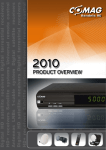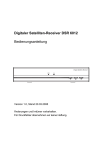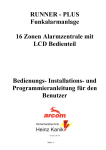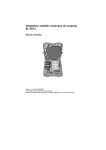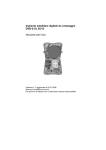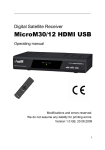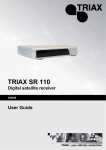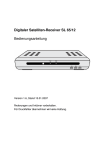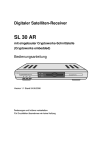Download Micro Digital Satellite Receiver Specifications
Transcript
Digital Satellite Receiver Operating manual Version 1.0, as of 21/11/2007 Modifications and errors reserved. We will not assume any liability for printing errors. 1 Overview of equipment Front side of the receiver Rear side of the receiver Remote control 2 Overview of equipment Front side of the receiver 1 - 2 LED STBY 3 LED ON 4 Standby 5 CH+ key 6 CH- key Infrared sensor for the signals of the remote control LED is only illuminated if the receiver is in standby mode LED is illuminated if the receiver is switched on Switches on and switches to the standby mode Switches to the next higher channel location Cursor moves up Switches to the next lower channel location Cursor moves down Rear side of the receiver 1 2 LNB IN IF OUT 3 4 5 6 7 TV (output) DC IN 12V AUDIO R AUDIO L Video LNB connection for the antenna cable LNB connection for an analogue satellite receiver in standby mode SCART connection for the TV set Connection 12V/power pack Analogue audio connection R(Right) Analogue audio connection L(Left) RCA video connection 3 Remote control No. Symbol Description 1 Standby Switches on and switches to the standby mode 2 ZOOM Enlarges TV image 3 LIST Invokes TV channel list 4 TIMER Invokes timer 5 TEXT Invokes Teletext 6 MUTE Turns off sound 7 M/P Multi-picture function, invokes thumbnail view 8 V+ Increases volume/cursor moves to the right 9 OK In normal mode: invokes current channel list In a menu: confirms menu item 10 CH ▼ Switches to the next lower channel location/ cursor moves downwards 11 FAV Invokes own favourites list 12 RECALL Switches to previously selected channel 13 PAUSE Stills the frame 14 INFO Displays reception data of the current channel (satellite-finder function) 15 0-9 Selects channel directly, numerical input 16 P- In normal mode: change of channel group In TV channel list: Ten-key block commutation 17 P+ In normal mode: change of channel group In TV channel list: Ten-key block commutation 18 V- Decreases volume/cursor moves to the left 4 19 CH ▲ Switches to the next higher channel location/cursor moves up 20 MENU Invokes main menu 21 EXIT Exits menu or menu item 22 Audio Changes audio mode 23 EPG Invokes Electronic Programme Guide (if offered by the broadcasting station) 24 TV/SAT Switches between terrestrial and satellite antenna 25 TV/Radio Switches between TV and radio mode 5 Preface This operating manual will help you in the • appropriate • safe Usage of the digital satellite receiver, hereafter called as the receiver in short. We assume that the user of the Sat-System has overall knowledge regarding handling of audio and video equipment. Every person who • installs, • connects, • operates, • cleans • disposes of This receiver must be familiar with the entire content of this operating manual. Always keep this operating manual in the proximity of the satellite system. Style features Specific style features have been given in different sections of the operating manual. Thus, you can easily differentiate whether it concerns Normal text, • enumerations or Actions. 6 Contents Overview of equipment....................................................................... 3 Remote control ................................................................................... 4 Preface............................................................................................... 6 Style features .................................................................................... 6 Contents ............................................................................................ 7 Safety instructions ........................................................................... 9 Basic safety instructions............................................................. 9 Appropriate usage ............................................................................ 12 Scope of supply.............................................................................. 13 Description ...................................................................................... 14 Receiver connection ...................................................................... 18 LNB cable installation ....................................................................... 19 Connection with Scart cable ............................................................. 21 Connection with Cinch cable ............................................................ 23 Connection of an audio-digital receiverFehler! Textmarke nicht definiert. Direction of the antenna ................................................................... 25 Getting started ................................................................................ 26 Remote control ................................................................................. 26 Receiver............................................................................................ 27 Adjustment of antenna...................................................................... 28 Operation......................................................................................... 29 Screen-inlays while switching a channel .......................................... 29 User interface on the TV monitor ..................................................... 30 Menu Structure ................................................................................. 31 Menu navigation ............................................................................... 32 Channel (symbol: TV)....................................................................... 33 Installation (symbol: satellite antenna) ............................................. 35 System settings (symbol: gearwheel)............................................... 39 Setting (symbol: tools) ...................................................................... 42 Software update via satellite............................................................. 43 Keys with special functions .......................................................... 44 7 Switch between TV and SAT............................................................ 44 Switch between TV and radio........................................................... 44 ZOOM ............................................................................................... 44 LIST .................................................................................................. 44 AUDIO .............................................................................................. 45 EPG .................................................................................................. 45 Teletext ............................................................................................. 45 M/P Multipicture ................................................................................ 46 MUTE................................................................................................ 46 FAV................................................................................................... 46 RECALL............................................................................................ 47 Acoustic signal for directing the satellite antenna ............................ 47 Sleep timer ....................................................................................... 47 Pause................................................................................................ 47 Dismantling ..................................................................................... 48 Cleaning........................................................................................... 48 Troubleshooting ............................................................................. 49 Technical specifications ................................................................ 51 Manufacturer ................................................................................... 53 Guarantee ........................................................................................ 53 Declaration of conformity .............................................................. 54 Glossary .......................................................................................... 55 Information regarding alignment of dish (UK)..........................56 8 Safety instructions Please read the safety instructions carefully before operating the receiver. Please follow all warnings and instructions on the equipment and in the operating manual. Basic safety instructions Electrical connection • Do not expose the receiver to rain as well as any kind of humidity to avoid risk of fire and electric shock. • Never open the casing. Otherwise, there is a risk of electric shock. • Connect the receiver only to the power source installed by an expert. It is either: - for an external power pack: A 100–240 V, 50-60 Hz mains socket as per specifications or - for a 12 V cable: An 11 V / 15 V DC supply as per specifications. • Ensure that the total power consumption by the antenna connection of the receiver does not exceed “LNB IN” 300 mA. • Pull the external power pack or the 12 V cable out of the mains socket if you will not use the device for a longer period of time. Only pull at the external power pack or at the head piece of the 12 V cable, not at the cable itself. • In case of a storm, pull the external power pack or the 12 V cable of the receiver out of the mains socket. • If foreign bodies or fluids enter the receiver, pull the external power pack or the 12 V cable out of the mains socket. Ask a qualified person to check the equipment before operating it once again. Otherwise, there is a risk of electric shock. • Do not bend or crimp any cable. • If a cable used for mains supply is damaged, the receiver must be repaired by an expert before re-using it. Otherwise, there is a risk of electric shock. 9 • Never allow children to operate the receiver or to play with the antenna unit unless supervised. • Always ask qualified personnel to carry out maintenance jobs. Otherwise, you are putting yourself and others at risk. • Disconnect the receiver from the power source in case of operational disruptions. • Ensure that the power source is easily accessible. Correct position • Place the receiver on a stable and even base. • Use the receiver only with adequate climatic conditions. • Avoid proximity to: - heat sources, e. g. heaters, - naked flames, e. g. candles, - Devices with strong magnetic fields, e. g. loudspeakers. - Never place receptacles filled with liquid (vases) on the receiver • Avoid direct sunlight and places with an extremely high amount of dust. • Never cover ventilation slits. Provide for sufficient ventilation by maintaining a safety distance of 5 cm to other objects. • Do not place any heavy objects on the receiver. • Humidity may settle in the receiver if it is brought into hot surroundings from a cold one. In this case, wait for about an hour before operating the equipment. • Arrange all cables in such a manner that no-one steps or trips over them. • The antenna unit is not suitable for operating in case of high wind pressures. Do not expose it to strong wind. Correct battery handling • Batteries may contain toxic agents. Ensure that batteries are not within the reach of children. Children may eat and swallow batteries. 10 • Batteries that are getting discharged may damage the remote control. If the receiver is not in use for a longer period of time, remove the batteries from the remote control. • Batteries may contain toxic agents. Therefore, dispose of the batteries immediately in an ecologically accepted manner according to the prevailing statutory regulations. Never throw the batteries into normal household waste. • Never expose the batteries to open fire or strong heat, as there is a danger of explosion. • Replace the batteries always with batteries of the same type. Explanation of safety instructions The following categories of safety instructions are included in the operating manual: Danger! Instructions with the word DANGER give a warning against possible personal injuries. Caution! Instructions with the word CAUTION give a warning against possible material or environmental damages. These instructions contain special information for commercial usage of the satellite system. 11 Appropriate usage The receiver receives unencoded digital channels (free-to-air) in a covered area. It is exclusively meant for this purpose and should only be used for the same. This also includes paying attention to all information in this operating manual especially that of safety instructions. Any other usage is considered to be improper and may lead to material damages and even personal injuries. Moreover, it will result in the immediate loss of warranty. The manufacturer does not bear any liability for damages caused due to improper usage. 12 Scope of supply Check the scope of supply after purchase. The scope of supply may vary according to the type of the receiver. Please follow the information on the packaging. Item Quantity Description 1 1 Receiver 2 1 Remote control unit 3 2 Battery Type LR 03/AAA/1,5 V 4 1 External power pack 1 Operating manual (not shown above) 13 Description You can receive unencoded (free-to-air) digital satellite channels with this receiver. It is not necessary to programme the receiver yet. The most important broadcasting stations and satellites have already been pre-programmed. The following satellites have been pre-programmed by the company: • Astra1 19° East • Hotbird 13E • Turksat 42E • Sirius2 5E • Amos 4W/Atlantic4-5W • Astra2 28° East (UK English satellite) • Eutel W2 16E • AtlanticBird3 5W (former France Telecom 2D) • HispaSat 30W • HellasSat 39E • ASTRA 23.5E The satellite antenna has to be directed towards the desired satellite. The receiver will scan for further new broadcasting stations as soon as you initiate the automatic scanning of broadcasting stations for this satellite. Satellites which are not pre-programmed may be added. All receiver settings can be done easily using the user interface (menu) on the TV monitor. The multilingual user interface supports the following languages: • German 14 • Greek • Croatian • Czech • Danish • Dutch • Hungarian • Norwegian • Polish • Slovakian • Swedish • Slovenian • English • French • Turkish • Spanish • Italian • Portuguese Other features of the equipment: • Software updates via satellite ASTRA 19° East • Short switching time, fast boot process when switching on the receiver • Saves the channel last watched (Last Station Memory) • LNB control logic (sound 0/22 kHz), max. current delivery for LNB 300 mA • Symbol rate 1-35 MS/s and 950-2150 MHz input frequency • Manual PID entry possible • 3 keys at the frontage • Plug & play • External power pack 100–240 V, 50/60 Hz, output 12V; 0.75A • 4.500 channel storage locations 15 • Child lock (preset password: 0000) • 1 favourites list and 8 channel groups • Automatic scanning of broadcasting stations • List editor for broadcasting stations • Analogue sound output through Cinch connector (stereo), volume adjustment possible via remote control • 1 Euro-SCART connection for TV and video set • Video output signal CVBS • Loop-through-function in standby mode for the connection of an analogue receiver • Super fast videotext with a memory of 800 pages • Digital radio reception, background image for radio (background display) • Additional channel information is displayed when the channel is changed. • DiSEqC 1.0, 1.2, Go-to X is supported if an appropriate antenna unit is connected • SWAP function (via Recall key) • Screen aspect ratios can be set to 4:3, 16:9, and automatically (letterbox) • Multi-functional timer, 8 x and linked with EPG, sleep timer • Electronic Programme Guide EPG (up to 14 days in advance, channel-dependent) • SCPC/MCPC reception standard C/Ku-Band satellites • Automatic selection of the TV standard with video converter • Zoom function • Multi-picture function 16 • Digital satellite finder for optical and acoustic adjustment of the parabolic-type reflector A suitable channel editor is additionally available through our hotline. Then you will be able to edit the channel lists of the receiver using your computer. Please read the information on our website for this purpose. 17 Receiver connection The receiver is connected with your satellite antenna by means of a coaxial cable. If necessary, you have to prepare a coaxial cable before connecting the receiver. Caution! Connect the receiver to the mains supply only after you have connected it to all equipment and the antenna properly. Otherwise the receiver can suffer damages. The wire netting and the inner core of the coaxial cable carry current during operation. Usage for camping or in caravans: The receiver can also be operated with 12V (i.e. 11-15V, e.g. solar panel). For this purpose, use a 12V cable. Usage with a voltage of 24V (e.g.: freight vehicles): Please use a 24V / 12V DC/DC converter. 18 LNB cable installation (see the installation diagram on the next page) For the installation of the F connectors on the coaxial cable you need a knife (ideally a wire stripper) and side cutting pliers. Cut 8 mm of the coaxial cable at each end up to the inner core. Carefully cut 10 mm of the outer insulation so that the wire netting is exposed. Turn the wire netting backwards and wind it over the outer insulation in such a manner that it does not touch the inner core. Remove the inner insulation up to 2 mm from the wire netting. Rotate the IF connector onto the turned-back wire netting till the connector touches the inner insulation. The wire netting must not protrude from the back of the connector end. Cut the inner core with a cable cutter in such a manner that it projects maximum 1 mm from the connector. 19 Installation diagram Fasten the F connector of the coaxial cable onto the “LNB IN” antenna connection of the receiver. Fasten the other end of the coaxial cable to the LNB. 20 Connection with Scart cable Insert the Scart cable in the “TV Scart” Scart socket of the receiver. Connect the Scart cable to the TV set. Follow the operating manual of the TV set. Connection diagram A scart cable is not included in the scope of supply. 21 22 Connection with Cinch cable Connect the Cinch connectors of the Cinch cable to the “AUDIO R” and “AUDIO L” sockets of the receiver if you want to connect a stereo system. Please also connect the “VIDEO” output to your TV Set to have the picture via Cinch. Caution! Never connect the Phono input of your stereo system to the receiver; it may damage your stereo system. Strictly follow the instructions for connecting the Cinch cable given in the operating manual of your stereo system. The Cinch cable is not included in the scope of supply. 23 Connection diagram 24 Direction of the antenna You must connect the LNB cable to LNB before directing the antenna. Caution! While connecting the LNB cable, the receiver must not be connected to the mains supply. Fasten the F-connector onto the connection of LNB on which the sealed socket is located. Insert the sealed socket into the LNB connection. The sealing lip of the socket must be engaged with the connection; only then is the connection protected from humidity. After installation, direct the antenna towards the satellite through which you would like to receive signals. Use the satellite locator compass for this purpose. Proceed as described in the operating manual of your satellite system. For UK see page 57. For fine adjustment of the antenna, please proceed as described in the operating manual of your satellite system. During the fine adjustment of the antenna, the acoustic signal indication can also help you. However, it can only be activated when running a manual scan. Here, a high tone indicates a good antenna direction, while a low tone indicates a bad antenna direction. 25 Getting started Remote control Two Micro type batteries are required for the remote control: LR 03/AAA/1.5 V Open the battery compartment. Insert two batteries into the battery compartment paying attention to the indicated polarities and push the cover of the battery compartment carefully until the cover is locked. Replace discharging batteries immediately. Always replace both batteries simultaneously and use batteries of the same type. If any battery has leaked, wear protective gloves and clean the battery compartment with a dry cloth. Caution! Batteries may contain toxic agents that are hazardous to health and environment. Therefore, dispose of the batteries immediately according to the prevailing statutory regulations. Never throw the batteries into normal household waste. The remote control transmits infrared signals to the receiver. Please refer to the overview of the remote control for the functioning of the keys. Point the remote control towards the front side of the receiver and slightly press the corresponding key once. 26 Receiver Caution! Check the proper connection of all devices and of the antenna before connecting the external power pack or the 12 V cable of the receiver to the power source and starting the receiver. Insert the mains plugs of the connected equipment in the mains socket and switch it on.. Switch on the AV channel of the TV set. Insert the power pack of the receiver in the mains socket. The device is in normal mode. The green LED is lit. If you wish to operate the receiver with 12V, insert the 12V mains cable in the “DC IN“ socket and connect it to your power source. The receiver is supplied with pre-programmed TV channels and can be used directly. If you want to check if new channels are available, initiate a scan for broadcasting stations. Read the information further below for this purpose. To get into standby mode, press the red key at top right of the remote control. The red LED of the receiver is lit. 27 Adjustment of antenna The reception quality set by you in the antenna settings may not be optimal. In this case, you must do a fine adjustment of the antenna. For this procedure, please see the operating manual of your satellite system. For UK see page 57. By pressing the “INFO” key, the current reception parameters are displayed. Please keep in mind that the signalstrength indication only shows the connection quality of the antenna to the receiver and is not intended to be used for the direction of the antenna. By pressing the 1 key, an acoustic signal is offered additionally to support you during the fine adjustment. A stronger and higher signal indicates a better direction of the antenna. As soon as the signal quality has reached approx. 60%, the channel image appears in the background. Should there be no image, you might have directed the antenna to another satellite instead of Astra1 19°. In this case, please find in the operating manual of your satellite system how to proceed. 28 Operation Screen-inlays while switching a channel When a channel is switched, an information bar is inlayed on the screen for 5 seconds (adjustable). In this information bar, you will find the following indications: Channel name Received satellite Current date Current time Storage location TXT symbol This symbol is displayed if the selected broadcasting station offers Teletext. EPG symbol This symbol is displayed if the selected broadcasting station offers a programme guide. Heart symbol The heart symbol is displayed if you have included the channel in your favourites list. Channel group symbol The corresponding channel group symbol is displayed if you have included the channel in your channel list. Info Information on the current and the following programme Info Information on the currently active channel list 29 User interface on the TV monitor You can do individual settings of your receiver using the menus in the user interface. For this purpose, both the receiver and the TV set need to be switched on and connected by a cable (SCART or CINCH). Press the “MENU” key. The main menu will be displayed. By pressing the “EXIT“ or the “MENU“ key, you can exit this menu again. Orientation within the menus At the top: menu name (the corresponding function symbols are displayed at the bottom) Below: sub-menu or menu items At the bottom: The information bar indicates the keys with which you can move yourself within the current menu. 30 Menu Structure Main menu Sub-menu Description Language (symbol corresponding country flag) Language selection Selection of the language in which the OSD menu is to be displayed. Channel (symbol: TV) TV Channel List See following text Radio Channel List See following text Delete All See following text Installation (symbol: satellite antenna) Antenna Setup See following text TP Scan See following text Preset Scan See following text Auto Scan See following text Audio Language See following text TV System See following text Channel setup See following text Time & Timer setting See following text OSD Setting See following text Parental Lock See following text LNB Power See following text Default Value See following text Software-Update See following text Game See following text Information See following text System Setup (symbol: Receiver) Tools (symbol tool case) 31 Menu navigation Use the keys “CH+”, “CH-”, “V+”, and “V-” to navigate within the menus. The selected menu items are marked. Confirm your selection with the “OK” key. By pressing the “EXIT” key you can exit the menu again. Changes must be confirmed additionally. Apart from this, the numerical keys are required in further submenus. In each menu, an information bar will be indicated containing all selection options. Example: Resetting the receiver to daylight saving time. Press the “MENU“ key, select system settings, then go to date & timer setting, press the “OK” key, select time and press the “OK” key again. Set “GMT+02:00“ in the item GMT difference. Exit the menu by pressing the "EXIT“ key. Setting for Central Europe: Daylight saving time: GMT+02:00 Winter time: GMT+01:00 32 Channel (symbol: TV) Sub-menu Description TV channel list 1 Favourite, 2 Move, 3 Find, 4 Sort, 5 Edit, 6 Type, ▲▼Select, V- V+ Group, OK Enter, EXIT. Radio channel list as indicated above Delete all Deletion of the complete channel list. For this purpose: Enter password (factory setting 0000) and confirm warning message with Yes. 1 Favourite By pressing key 1 you can determine your favourites. Next to the corresponding channels, a heart symbol will be displayed. 2 Move By pressing key 2, the movement symbol will appear behind the marked channel. By pressing the keys CH+ and CH-, the channel will be moved to the desired position. The procedure must be confirmed with OK. 3 Find Channel scan function. By entering letters in the appearing keyboard, a filtered channel scan is possible. 4 Sort Sorting of the complete channel list according to the offered options. The list must be confirmed with OK. As long as the list has not been confirmed, the last status before confirming can be restored. 33 5 Edit After entering the password (factory setting 0000), new selection options will appear. Sub-menu Description Edit 1 Delete, 2 Skip, 3 Lock, 4 Create, 5 Edit, 6 Del all, ▲▼Select, V- V+ Group, P+PPage, EXIT Exit. 1 Delete By marking with key 1, selected channels can be marked to be deleted. Please confirm selection by pressing the "OK“ key. 2 Skip By marking with key 2, selected channels can be marked to be skipped. Please confirm selection by pressing the "OK“ key. Then, the selected channels are skipped when zapping. A direct entry is still possible. 3 Lock By marking with key 3, selected channels can be marked to be blocked. Please confirm selection by pressing the "OK“ key. Then, the selected channels require the entry of a password (child lock). 4 Create Via key 4 you will change over to the editing mode. Here, you can change the individual parameters as desired. Please confirm selection by pressing the "OK“ key. 5 Edit Via key 5 you will change over to the new entry mode. By entering the frequency and PID directly, you can enter a new channel. 6 Del(delete) all Via key 6 you can mark all channels to be deleted. Thereafter, individual channels can be deselected again by pressing key 1. Please confirm selection by pressing the "OK“ key. 34 6 Type (channel group) Here, you can assign selected channels to determined channel groups (Types) as desired. Please confirm your selection with “OK”. You can exit the menu by pressing the "EXIT“ key. Installation (symbol: satellite antenna) Sub-menu Description Antenna setup Satellite Satellite selection (example: Astra1 19.2° East) LNB Type Select LNB type (default value is Universal) 22K 22KHz activation, (Note: with LNB type Universal, activation occurs automatically) DiSEqC Select DiSEqC level DiSEqC Switch Select DiSEqC command Example: Astra and Hotbird double reception Astra = 1 / 4 Hotbird = 2 / 4 Disable for positioner: Not enabled Positioner By pressing the “OK“ key you will go to DiSEqC positioner menu. Please refer to the operating manual of your DiSEqC motor for help. Polarity Horizontal, vertical, H/V (automatic operation) TP Scan (manual channel scan) With this scanning function, you can scan the preset frequencies (transponders) individually. The transponder details can be changed manually. The procedure is initiated with “Scan“. 35 Preset Scan Auto Scan (unique function that can be used without any previous knowledge), Satellite Selection of the satellite to be scanned TP Index Frequency selection The selection options are displayed 1 Add, 2 Delete, 3 Delete all See following table for TP Index. TP Frequency Setting of the frequency Symbol Rate Setting of the symbol rate Polarity H = horizontal, V = vertical Scan Mode all = encrypted and unencrypted channels Free = only unencrypted channels Search Start scan by pressing the OK key. The channels and frequency found are added. Scanning of preset frequencies (transponders). (Normal automatic scan) Satellite Selection of the satellite to be scanned Scan Mode all = encrypted and unencrypted channels Free = only unencrypted channels Scan Channel Selection between TV and radio or only TV or only radio Search Start scan by pressing the OK key. Here you can scan a selected satellite (example: Astra1 19.2° East) completely to search for new channels. For this purpose, no special information is needed. You can choose between free-to-air channels and all TV and radio channels. The procedure is initiated via “Scan”. 36 The signal strength and quality is displayed permanently. Satellite Selection of the satellite to be scanned Scan Mode all = encrypted and unencrypted channels Free = only unencrypted channels Scan Channel Selection between TV and radio or only TV or only radio Search Start scan by pressing the OK key. The channels found are added. 37 Table for the TP Index No. Sub-menu Description 1 Add Create new frequency (transponder): Menu item "TP frequency": Frequency: set desired frequency Menu item "Symbol rate": set corresponding symbol rate Menu item Polarity: set corresponding polarisation The new frequency (transponder) is created after execution. When exiting the menu confirm the safety message by pressing the OK key. Only after confirmation the new frequency will be created. For scanning the newly created frequency, initiate the menu item "Scan". 2 Delete Delete the selected transponder. When confirming the safety message, the transponder and all channels on it will be deleted. 3 Del(ete) all When confirming the safety message, all transponders and all channels on them will be deleted. 38 System settings (symbol: gearwheel) Sub-menu Description Audio Language First Audio Preselection of audio language (if offered by the broadcasting station) Second Audio Preselection of audio language (if offered by the broadcasting station) Display Mode Selection of the transmission system Default selection: Auto Aspect Mode Selection of the aspect ratio Default selection: 4:3 Letterbox Video Output CVBS Dolby Digital Enable (On) / disable (Off) TV System Channel setup Start-up channel: Determination of the desired TV or radio channel appearing when switching on the receiver Start-up Channel Enable (On) / disable (Off) Mode TV = the start-up channel is a TV channel Radio = the start-up channel is a radio channel Start-up Channel: By pressing the OK key, a channel list will be displayed for selecting the start-up channel. Confirm the selected channel by pressing the OK key. 39 Time & Timer Setting OSD Setting Time Optional input of time and time zones. See following table for time setting. Timer See following table for timer setting. Subtitle Display Enable / disable OSD Timeout Menu display time (OSD time lock) OSD Transparency Menu transparency Load Default OSD Setting OSD default value can be restored Parental Lock Factory password: 0000 (password settings) Installation Lock Deactivation of password input in the Installation menu Channel Lock Deactivation of password input for locked channels (parental lock) New Password Input of a new password. (Make sure you will remember the new password) Confirm Password Confirm new password. LNB Power Enabling and disabling LNB power supply. ON is preset. 40 Table for timer setting Sub-menu Description Timer Number Selection of timer number 1-8. Timer Mode Type of repetition (once, daily, weekly, monthly, annually, off). With the setting “Off“, the timer will be disabled. Timer Service Switching between programme timer (TV or radio channels) and reminding function (message). Wakeup Channel With the timer service setting “Message“, you have following options: Birthday, Anniversary, and General With the timer-service setting "TV Channel“ or "Radio Channel“, you can select channels Wakeup Date Date input with the keys 0-9 of the remote control On Time Time input with the keys 0-9 of the remote control Duration Input duration of the event with the keys 0-9 of the remote control. However, the timer can also be programmed via the EPG mode. Example: Press “EPG“ key. Via key 1 you then will get an event list. By using the keys CH+ and CH-, you can select the desired event and take it over directly to the timer by pressing key 2. 41 Setting (symbol: tools) Sub-menu Description Default Value Reset receiver to the default value. All changes are cancelled. If the receiver is reset to the default values via the OSD menu, the language selection appears in the main menu after completion of the procedure. Now, switch off the receiver with the mains switch. As soon as 5 seconds have passed, you can switch it on again. In the condition as supplied to the customer, the receiver starts in normal mode. (requires password input) Please note: the default values are restored if you keep the standby key at the front side of your receiver pressed for more than 10 seconds. Software-Update Please note: A software update has NOTHING to do with a scan for new TV channels. Therefore, please initiate an automatic scan. By means of a software update you can load new operation software in case of need. An update via satellite or RS232 is also possible. Game Here, the three games Tetris, Snake and Othello are available. Information Technical details 42 Software update via satellite The update has nothing to do with the storage of new TV channels. It is rather meant to update the system software of the receiver. Normally, the update is not required for a trouble-free operation of the receiver. You must direct your satellite system towards the satellite ASTRA 19° East to be able to update the software. Updating the software may take up to an hour. After the upgrade, it is recommended to load the factory settings additionally. PLEASE NOTE: with this, the channel list you created will be deleted. 43 Keys with special functions Switch between TV and SAT With the “TV/SAT” key you can switch between TV and satellite functions. (This function has to be provided by your TV set). Press the “TV/SAT” key until you have set the desired function. Switch between TV and radio With the “TV/Radio” key you can switch between TV and the radio function. Now, the receiver transmits a radio channel and shows a background image. To return to the TV channel, press the “TV/Radio” key of the remote control. ZOOM With the zoom function you can enlarge a section of the image. Press the “ZOOM” key twice. Select the image section with the keys CH-, CH+, V- and V+. With each pressing of the “ZOOM” key, a section of the image will be enlarged up to a maximum of 6 x. With the seventh key pressure, the image will return to its original size. By pressing the “EXIT” key, you can exit this mode. LIST Press the “LIST” key once. Here you have the option to edit the channel list as already described earlier under menu item “Channel“. 44 AUDIO With the “AUDIO” key you can select the audio track if a broadcasting station offers multi-channel sound. Additionally, you can activate the Dolby Digital mode here. (For this purpose you additionally need a Dolby Digital system. The connection is made on the rear of the device via the COAXIAL socket). EPG Electronic Programme Guide. To activate this function, please press the “EPG“ key. The channel list appears. With the keys CH+ and CH-, you can select a channel. On the right side, the current and following programme will be displayed. For additional information, please press key 1. The complete event list will be displayed. With the keys V+ and V-, you can scroll up the days. With the keys CH+ and CH-, you can scroll up and down the events. Detailed information for a selected event (programme) will be displayed by pressing key 1. An event can be directly taken over to the timer by pressing key 2. Teletext Teletext is an information system displaying Teletext on your TV set. For Teletext reception, the selected channel must support this function. The TXT symbol appears when channels are changed. Comparing our receiver to others you will notice that our Teletext is extremely fast. Press the “TEXT" key to start Teletext. For switching off Teletext, press the “EXIT” or “TEXT” key. 45 Using Fast text functions The coloured keys on the remote control are meant for Fast text and are activated after invoking another Teletext page. You can get there directly by pressing the small coloured keys on the remote control. Press the desired key. M/P Multipicture Press the “M/P" key to go to the multi-picture mode. Now, 9 channels will appear simultaneously on your screen, starting with the current channel. With the keys CH-, CH+, V- and V+, you can move the yellow marking bar. The marked channel is displayed in real time. All other channels are displayed as freeze images. To activate the desired channel, mark it and then press the “OK” or the "EXIT” key. By pressing the “EXIT" key, you will leave the multi-picture mode. The channel you marked last will appear as complete image on your screen. MUTE By pressing the “MUTE" key, the sound will be turned off. By pressing the “MUTE" key again, the sound will be turned on again. FAV Press the “FAV” key. The screen shows the favourites you determined (see above). Select a channel from the favourites list. Press the “OK” key to select. With the keys V+ and V-, you can switch between the channel groups. 46 RECALL By pressing the RECALL key, you will change over to the previously selected channel. Acoustic signal for directing the satellite antenna For this purpose, press the “INFO” key. Apart from the current reception parameters, you will get information on the signal strength and quality. Additionally, you can activate an acoustic signal by pressing key 1. An acoustic signal is transmitted via the TV set. A stronger and higher signal indicates a better direction of the antenna. Sleep timer You can go to the sleep timer in normal mode by pressing key 0. You have the following setting options: off, 10, 30, 60, 90, 120 minutes. After this time, the receiver will be switched off automatically. Pause For this purpose, press the “PAUSE” key. The TV image will be "frozen“. By pressing the "PAUSE" key again, it will be deactivated. 47 Dismantling Disconnect the receiver and connected equipment from the power supply. Loosen the LNB cable from the receiver and LNB. Take the batteries out of the remote control, if you will not use the receiver for a longer period of time. Pack the receiver, the remote control, the 2 batteries, the external power pack and the 12V cable for the cigarette lighter into the cardboard box. Store the receiver at a dry and dust-free place. Protect the receiver from frost. Cleaning Caution! The receiver must not become wet. Never clean it with a wet cloth. Do not use any cleaning agent containing solvents like petrol or thinners for cleaning. These agents may damage the surface of the casing. Clean the casing of the receiver with a dry cloth. 48 Troubleshooting Symptom Possible cause and remedy Satellite cannot be found, or no signal Example: Astra1 19° East Key 1 (presetting: “ARD“) Key “INFO“ (“ARD“, FR11837) Signal AND quality are both at 0% Direct vertical reflector towards south. Turn some millimetres to the left, wait approx. 3 seconds and repeat until signal AND quality are displayed. With a signal of approx. 60%, the black background will disappear and the TV image will be displayed. For another satellite please select a current channel from the pre-programmed channel list and then press the “INFO” key. No LED is illuminated The external power pack and/ort he 12V cable are not connected. Connect the external power pack and/ort he 12V cable to the mains supply and to the receiver. No sound or image, but receiver menus are displayed The antenna is not directed towards the satellite. Direct the antenna properly. No signal (with symbol). Check the cable connection from LNB to the receiver and from the receiver to the connected equipment. Direct the antenna. The green LED is lit, TV set does not show any image. The system is not connected properly. Check connection of the SCART cable The TV set is not in AV mode. Switch the TV set to the respective AV input. 49 Poor image, blocking error, formation of small blocks, sound stops The antenna is not directed exactly towards the satellite. Direct the antenna more precisely. For this purpose, use the “Info” key on the remote control. The signal strength will be displayed for directing the antenna properly. The LNB is defective. Replace the LNB. No image, no sound, signal strength OK, no signal quality The satellite antenna has been directed to a wrong satellite. Bad reception of: Tele5, DSF, etc. Wireless telephone is disturbing (DECT standard). Put the telephone to another place, use a better satellite cable. The remote control does not work The batteries are exhausted. Replace the batteries. The remote control is not directed properly. Aim the remote control towards the front side of the receiver and ensure that there is no obstacle between the remote control and the receiver. Channel has a new frequency Delete the TV channel, and then scan automatically. If a malfunction cannot be rectified in spite of this, please contact your specialized dealer or the manufacturer. 50 Technical specifications Receiver Dimensions in mm (W × D × H) 45 × 145 × 210 Weight in grammes Receiver 660 g Remote control 80 g (without batteries) Input frequency range 950 MHz ~ 2'150 MHz IF band width 55 MHz / 8 MHz (below 5MS/s) LNB power supply 14V/18V GS, 0.30 A max. Overload protection LNB control 22 KHz ± 2 KHz, 0.6 V pp ± 0.2 V DiSEqC control Version 1.0, Version 1.2, Tone-Burst A/B Symbol rate 1 ~ 35 MS/s Bit stream ISO/IEC 115200 bit stream specification Input speed Max. 15 Mbit/s Error correction (FEC) 1/2, 2/3, 3/4, 5/6, 7/8, auto Aspect ratio 4:3 Letterbox, 4:3 PanScan, 16:9 Video resolution 720 x 576 (Pal), 720 x 480 (NTSC) Audio mode Left, right, stereo, AC3 digital sound Connection options LNB IF input Type F, IEC 169-24 TV SCART (output only) Video CVBS, Audio L, R VCR SCART (output and input) Video CVBS, Audio L, R RCA (CINCH) Audio L,R SPDIF, COAXIAL Digital audio output Power supply 51 Input voltage power pack 100-240 V ~, 50/60 Hz Input voltage of the receiver 11 – 15 Volt Power consumption approx. 12 W (operation with Single LNB) approx. 4 W (standby) Operating temperature 0ºC ~ +40ºC Storage temperature –40ºC ~ +65ºC 52 Manufacturer COMAG Handels AG Zillenhardtstrasse 41 D-73037 Göppingen GERMANY Tel: +49 (0) 7161 / 503060 Website: http://www.comag-ag.de Dear customer, Past experience has shown that many complaints can be settled through a simple telephone call. In case problems should arise with your device we kindly ask you to contact your service hotline first. Proceeding like this will save you time and possible irritation. Your hotline personnel will be glad to help you and explain the exact guarantee procedure, should it become necessary to send in your device. Contact your retailer for advice http://www.comag-ag.co.uk Guarantee The guarantee for the digital satellite receiver is in conformity with the prevailing statutory regulations at the time of purchasing the product. 53 Declaration of conformity The manufacturer hereby declares conformity with the following guidelines and standards for this product: Guideline for low voltage, 73/23/EEC • EN 60,065 Guideline for electromagnetic compatibility, 89/336/EEC • • • • EN 55,013 EN 55 020 EN 61000-3-2 EN 61000-3-3 Equipment type /model: Digital satellite receiver SL30/12 54 Glossary AC Alternating Current Connection for alternating current DC Direct Current Connection for direct current Cinch connector Coaxial connector for connecting TV set or stereo system. DiSEqC Digital Satellite Equipment Control Digital system, with which the receiver can control different components of the external unit. It is especially used for selecting from multiple satellite positions (for example Astra and Eutelsat). EPG Electronic Programme Guide F connector Coaxial connector for LNB antenna cable. FTA Free-to-air services Free-of-charge services that can be received without special decoder. LNB Low Noise Block Amplifier / Converter A device at the centre of the antenna, which converts high-frequency incoming signals from satellites into a low-frequency range and amplifies them simultaneously. Mute Key on the remote control for turning off sound OSD On-screen display Menu control displayed on the screen. PID Identification number of a received data stream. The PIDs ensure that a sender data is received completely. Receiver Receiver unit, which converts signals from the antenna to video and audio signals. 55 SCART A 21-pole connector for connecting the TV set to the receiver. Swap function Switches between current channel and channel last watched. Transponder Satellite frequency. Several digital programmes can be broadcasted simultaneously on a transponder. VCR Abbreviation for Video Cassette Recorder. 56 Dish Alignment Instructions & Information for UK customers who wish to receive English programs. Satellites are located every 3 degrees in a geostationary orbit 35,000 kilometres above the earths surface at the equator which is known as the Clarke Belt. No matter where you are on the earths surface the satellites will always be located at the same position the only thing that changes is the elevation as you move further north or south. Satellite transmissions are low power high frequency; in order to obtain useable signals you need clear line of site between your dish and the satellite. Any obstruction in the way i.e., buildings / towers / power lines can and will affect the signals received, in some cases eliminating the signals altogether. Selecting a fixing position for your dish is therefore critical to the success of the installation. In an open field situation there should be no problems unless something large is parked between you and the satellite. A built up area is somewhat more problematic, as a general rule of thumb look to place the dish as high as possible, the provided cable will allow a reasonable height to be achieved. A small difference in the location of the dish can have quite a significant effect on signals received. Assemble the dish as per the enclosed instructions. Ensure cable connections have been made correctly There should be no connection between the inner and outer sheath, if you find you have a connection it is likely a small strand of outer sheath has bridged to the inner core on one of your connectors. Do not turn on the power to your receiver. Connect the cable to the LNB on the dish (previously assembled as per instructions), uncoil the cable from the dish to the receiver. You will see that to uncoil the cable properly will require the twist to be removed from the cable, this can only be achieved properly with one end disconnected, once you have the cable laid out with no 57 twists, connect the other end to the LNB connection on the receiver unit. Ensure your scart connected to the TV is made correctly using the TV connection point on the receiver. Power up the TV, power up the Sat system, ensure the TV is in AV mode you should see an output from the receiver showing no signal. 1 2 3 4 5 6 7 8 9 10 Press menu on the remote control Using the blue keys on the remote select the right key until the highlighted indicator is on the geared cog symbol. Language selection should be set to English. Exit menu. Press List Select Astra 28 east by pressing the LEFT or RIGHT buttons Select BBC1 London (Highlight in Yellow) Press OK Now press INFO this will give you the parameters of BBC1 London and 2 meters on screen 1. is Signal Intensity and 2. is Signal quality. Press 1 key to get audible output from TV You are now ready to start to align the dish, if you have been changing settings previously ensure you have selected ASTRA28E, this should be indicated in the info screen. The dish setting clamp should be loosened to allow movement but tight enough to hold its position securely once an adjustment is made. 1 Identify due south with a compass. 58 2 3 4 5 Place the enclosed SATELLITE MAP on the ground in line with your dish and with the SOUTH arrow aligned correctly with the aid of the compass. Set the elevation of the dish vertical from horizontal (the dish has an offset designed in its construction). Look at the dish from the side, if the top and bottom is in line with a vertical line from the ground this is the starting point. Move the dish to be in line with the marking for ASTRA 1 28E on your SATELLITE MAP. When moving the dish try to remember you must keep the elevation as previously set, only adjust the horizontal direction for now as indicated above. Fine tuning It is at this point you rely on the audible signal generated from your receiver and through the TV, turn the sound up so you can hear it from the dish location. It is quite likely you still only have 36 – 37% signal intensity and 10 – 11% quality. The dish is pointing slightly towards the south, and not at the satellite. Carefully follow the fine tuning instructions. Remember do not adjust the elevation at this point, it should be set at vertical when viewed from the side. 1 Turn the dish on the horizontal plane towards the east (left as viewed from behind), 2 or 3 mm at a time and then wait to hear the audible signal indicator change, wait for two or three seconds, adjust 2 or 3 mm and wait again, after the second or third adjustment you should hear a change in the sound level, its a good idea to have a friend relaying the signal intensity and quality reading during this stage. 59 ONLY MOVE THE LNB ARM BY 2 OR 3 MM AT A TIME, IF YOU MOVE IT TOO MUCH YOU WILL GO PAST THE SATELLITE AND NO SIGNAL CHANGE WILL BE NOTED. IF YOU STAND IN FRONT OF THE DISH YOU WILL BLOCK THE SIGNAL, GET OUT OF THE WAY TO CHECK SIGNAL READINGS. 2 3 4 5 6 What you are trying to achieve at this point is an increase in the signal quality (the intensity will take care of itself). As you move the dish past the satellite the quality will go down (usually accompanied by a reduction in the audible tone). If all is well you have just located the satellite, you have gone from a low signal to the south of the satellite to a low signal to the east of the satellite. This typically takes place with no more than a 10 to 15 mm movement in the LNB arm (quite a fine adjustment), it is easy to see now why just moving the dish about and hoping will not work. Move the dish direction back towards the south to achieve maximum signal quality (this still may be quite low 14 to 18%), you now have the direction fine tuned. Now concentrate on the elevation, without moving the direction slowly move the LNB arm near the dish up thereby increasing the elevation from the horizon, yet again a peak will be noticed as you go past the optimal point, move the dish back down to achieve max signal quality. You have now narrowed the alignment to a small area, move the dish horizontally to the left until the signal falls, and then back to the right until the signal falls, in the middle is the correct alignment, if you go over this again first with the horizontal, and then the vertical you will have pinpointed the 60 highest signal and therefore the correct alignment of the dish to that particular satellite. At this point you should expect that a signal quality of 60 – 70 % and a signal intensity of 70% can be achieved. These instructions are good for a location from the midlands to the north, and as explained at the start elevation increases and decreases depending upon your location on the earths surface, so for the south of England elevation is about 5 degrees and for the north of Scotland the elevation needs to be minus i.e. the dish needs to be leaning forward 2-3 degrees. 61 62






























































